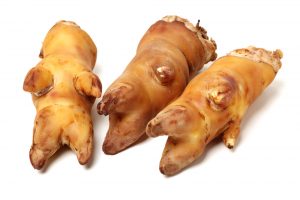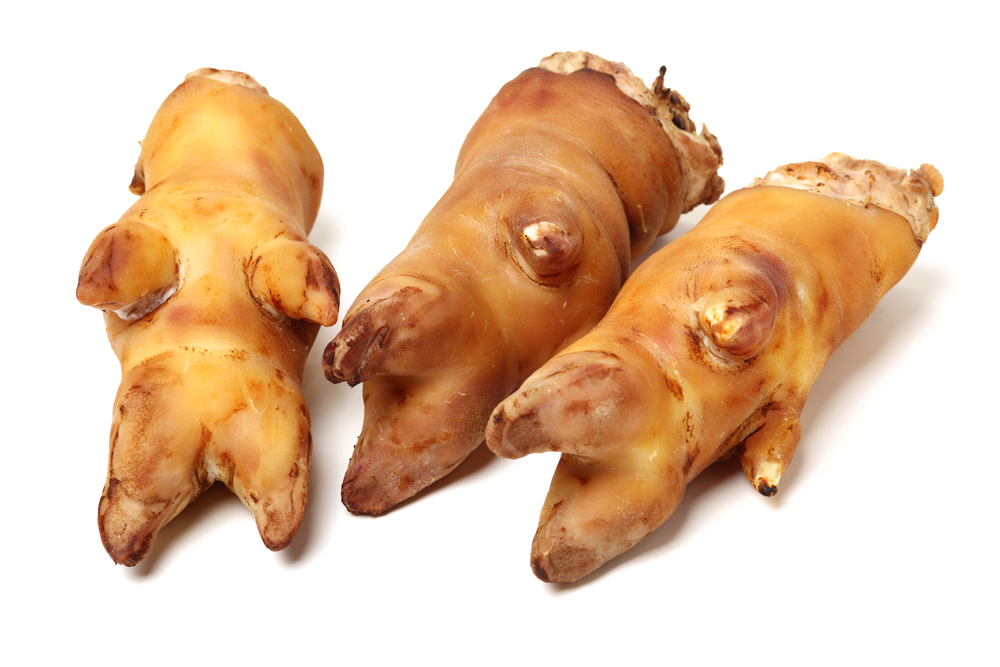As one of the most popular treats on the market, you might be wondering: are pig trotters good for dogs? How can you be sure that pig trotters are actually beneficial, or simply the latest trendy treat?
In this article, we’re going to take a closer look at the good, the bad, and the risky of giving pig trotters to dogs. By the end, you’ll know whether pig trotters are right for your pup and how you can be sure that their treats are truly healthy.

Are pig trotters good for dogs?
In general, pig trotters are considered a safe treat for dogs. When sourced and prepared properly, dogs can chew these hard-boned treats without risk of injury or major health concerns.
And, there are even some benefits to feeding your dog pig trotters. First of all, doggos love them! Pig trotters can serve as an engaging chew item when your dog might otherwise be sneaking off with your favourite pair of shoes. This makes them an excellent source of mental stimulation that will keep your dog happy and satisfied.
And since pups can’t easily swallow pig trotters, they’re usually safer than some chew toys.
There are some nutritional benefits, as well. Pig trotters are high in protein, iron, zinc and Vitamin B12, and they’re a good source of natural fat, which is good for your dog’s coat and joints.
The act of chewing can also provide your dog with some dental health benefits. While pig trotters shouldn’t be considered a replacement for your regular tooth brushing routine, they can be a good way to manage tartar build-up on your dog’s teeth.
As you can see, the question of are pig trotters good for dogs does have some compelling answers!
What are the health risks?
Before you fill your dog’s treat jar with pig trotters, let’s review some of the potential risks of this tasty treat.
For starters, giving your dog pig trotters too frequently isn’t great for a balanced, nutritious diet. This part of the pig is quite high in calories, and can lead to unhealthy weight gain when given too often.
And, if the idea of serving raw pork to your dog raises some red flags, it might be because raw pork has had some bad press over the years. Pork meat has been known to carry Aujesky’s disease, a.k.a. pseudorabies, and Trichinella spiralis, a life-threatening parasite. When contracted by dogs, the survival rate is extremely low.
That said, neither Aujesky’s disease nor trichinosis has ever been found in Australian pork. In fact, Australian pork is regarded as some of the safest in the world. So as long as your dog’s pig trotters are locally-sourced, feeding them raw shouldn’t be a problem.
Now, you might be thinking: if there was even a tiny chance of your dog contracting a food-borne illness from uncooked pork, shouldn’t you simply cook it? Well, this leads us to our next pig trotter health concern: bone splinters.
When pig feet are cooked, the bones lose their integrity, putting your dog at risk of ingesting bone splinters. For this reason, you’ll always find pig trotters for dogs in a raw or air-dried condition.
Finally, there’s the risk of stomach upset. While pork meat tends to be one of the most easily digestible sources of protein for dogs, not all puppers will react well to it. Specifically, small dogs, puppies, and senior dogs, in particular, are likely to react poorly to pig trotters. For this reason, most nutritionists only recommend them for adult dogs 10kg and over. In general, if your dog already suffers from stomach sensitivity, pork trotters may not be the best treat for them.
What is the best way to feed your dog pig trotters?
Now that we know some of the health risks of pig trotters, what kind of precautions can we take to keep our puppers safe? Here are a few tips:
- Be careful about the source. Because pig trotters are so popular with Aussie pups, it shouldn’t be hard to find them locally-sourced. This will lower the risk of the pork meat containing any food-borne parasites.
- Steer clear of seasonings. You might see smoked pig trotters marketed to Dog Owners with the selling point of better flavour. But, there are two reasons to steer clear of smoked flavours or any other seasonings. First, flavour additives tend to raise the salt content of the pig trotter, which can pose health hazards. And, the smoking process can make the bones more fragile and prone to breaking.
- Stick with raw pig trotters. When you feed your dog fresh pig trotters, you can be sure that they are free of harmful preservatives or additives.
- Store safely. Raw pig trotters can be safely stored in the fridge for up to three days or kept in the freezer. In fact, feeding your dog a frozen pig trotter will keep them entertained longer.
- Consider your dog’s overall diet. As we mentioned, too many meaty treats can lead to weight gain. Experts recommend to give your dog only one or two pig trotters per week or every couple of weeks so that they can stay healthy. In addition, you’ll want to make sure that your dog’s other meals are well-balanced. A healthy dog diet should include a good mix of nutritious meats and dog-friendly veggies to provide them with all the protein and minerals they need.
- Supervise your doggo. In some cases, dogs will attempt to bury their beloved pig trotters to save for later. This is, of course, a health concern, as it exposes the tasty treat to all kinds of dangerous bacteria. So, if you’ve got a doggy digger, make sure to keep an eye on pig trotter treat time.
- When in doubt, talk with your vet. If you’re not sure whether pig trotters are good for dogs like yours, make sure to get the go-ahead from your vet.
So, are pig trotters good for dogs?
The main takeaway here is that, yes, pig trotters can be a safe and beneficial treat for dogs! As with everything, quality and moderation are key. Make sure your dog’s pig trotters are locally-sourced and fresh, and don’t go overboard. That way, your pup can enjoy pig trotters as a chewy treat!


1 comment
My dog loves dried pig ears or trotters, but if I hold it she is content and chews on it for a while.